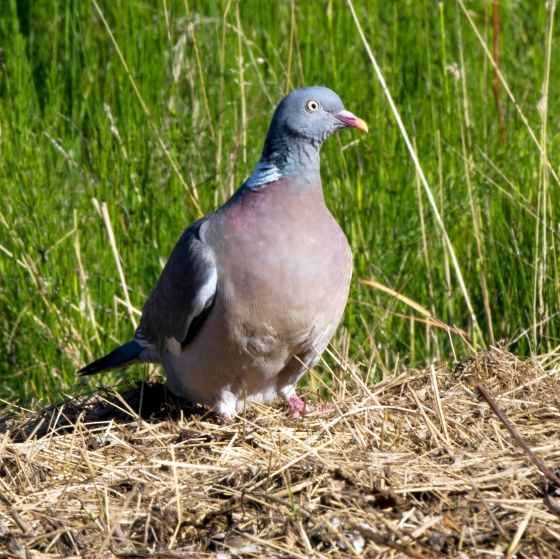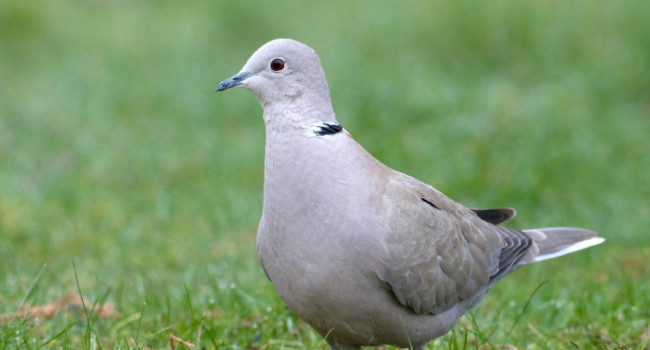Woodpigeon
Columba palumbus (Linnaeus, 1758)
WP
 WOODP
WOODP  6700
6700

Family: Columbiformes > Columbidae

The Woodpigeon is an attractive bird, all pinks and blue-greys, with a bright yellow eye and a red and yellow bill.
This common bird can be seen throughout the UK, across a range of habitats. The breeding population is thought to be around five million pairs, and this is a species that can nest at any time of the year, although its peak breeding season is through the summer months.
From late October through most of November, large flocks, sometimes numbering in the tens of thousands, can be seen on migration, flying high and south on clear, sunny days. Where they are going is open to debate but many thousands arrive in the Iberian Peninsula at this time.
Exploring the trends for Woodpigeon
Our Trends Explorer will also give you the latest insight into how the UK's Woodpigeon population is changing.
trends explorerIdentification
Woodpigeon identification is usually straightforward. The following article may help when identifying Woodpigeon.
Bird Song Basics - Collared Dove and Woodpigeon

In this video, Training manager Nick Moran explains the differences between Collared Dove and Woodpigeon songs.
Two of our more common garden visitors, they sound very similar - so make sure to find a mnemonic to help you keep them apart.
- 1 of 2
- next ›
SONGS AND CALLS
Listen to example recordings of the main vocalisations of Woodpigeon, provided by xeno-canto contributors.
Song
Develop your bird ID skills with our training courses
Our interactive online courses are a great way to develop your bird identification skills, whether you're new to the hobby or a competent birder looking to hone your abilities.
Browse training coursesStatus and Trends
Population size and trends and patterns of distribution based on BTO surveys and atlases with data collected by BTO volunteers.
CONSERVATION STATUS
This species can be found on the following statutory and conservation listings and schedules.
POPULATION CHANGE
The CBC/BBS trend for this species is of a steady, steep increase since at least the mid 1970s. This has only recently started to level off, with BBS showing a very shallow but statistically significant decline in England over the most recent five year period. Since 1995, BBS has recorded significantly upward trends in the UK, and in England and Northern Ireland separately, but stability in Scotland and Wales. The BBS map of change in relative density between 1994-96 and 2007-09 indicates that increase has been very widespread, with decreases only in parts of northeastern Scotland. Breeding success was increasing strongly during the 1970s and 1980s but is currently stable or in shallow decline. There has been an increase across Europe since 1980 (PECBMS: PECBMS 2020a>).
| UK breeding population |
+152% increase (1967–2022) 
|
Exploring the trends for Woodpigeon
Our Trends Explorer will also give you the latest insight into how the UK's Woodpigeon population is changing.
trends explorerDISTRIBUTION
Woodpigeons occupy virtually every 10-km square within Britain and Ireland with the exception of the higher mountain zones of Scotland and some northern and western islands offering little woodland cover. The highest densities occur in the arable eastern lowland regions of both Britain and Ireland, with marginally lower abundance in the more heavily wooded regions of southeast England and still lower abundance in pastoral areas.
Occupied 10-km squares in UK
| No. occupied in breeding season | 2752 |
| % occupied in breeding season | 91 |
| No. occupied in winter | 2646 |
| % occupied in winter | 88 |
European Distribution Map
European Breeding Bird Atlas 2
Breeding Season Habitats
| Most frequent in |
Deciduous Wood 
|
| Also common in | Scrub, Arable Farmland, Pasture Farmland, Villages, Towns |
Relative frequency by habitat
Relative occurrence in different habitat types during the breeding season.

DISTRIBUTION CHANGE
Relatively few gains and losses have occurred in either season and these are mainly along the northwestern periphery of the range.
Change in occupied 10-km squares in the UK
| % change in range in breeding season (1968–72 to 2008–11) | +0.2% |
| % change in range in winter (1981–84 to 2007–11) | +2.8% |
SEASONALITY
Woodpigeons are very widely recorded, present on over 60% of complete lists in all weeks of the year.

Movement
Information about movement and migration based on online bird portals (e.g. BirdTrack), Ringing schemes and tracking studies.
An overview of year-round movements for the whole of Europe can be seen on the EuroBirdPortal viewer.
RINGING RECOVERIES
View a summary of recoveries in the Online Ringing Report.
Foreign locations of birds ringed or recovered in Britain & Ireland

Biology
Lifecycle and body size information about Woodpigeon, including statistics on nesting, eggs and lifespan based on BTO ringing and nest recording data.
PRODUCTIVITY & NESTING
First Clutches Laid 
|
30 Apr (22 Feb–20 Aug) 
|
Number of Broods 
|
01–Feb |
Egg Size 
|
41×29 mm Weight = 18.9 g (of which 7% is shell) |
Exploring the trends for Woodpigeon
Our Trends Explorer will also give you the latest insight into how the UK's Woodpigeon population is changing.
trends explorerSURVIVAL & LONGEVITY
View number ringed each year in the Online Ringing Report
Maximum Age from Ringing 
|
17 years 8 months 19 days (set in 1999) 
|
Typical Lifespan 
|
3 years with breeding typically at 1 year |
Adult Survival 
|
0.607±0.016  
|
Juvenile Survival 
|
0.52 
|
Exploring the trends for Woodpigeon
Our Trends Explorer will also give you the latest insight into how the UK's Woodpigeon population is changing.
trends explorerBIOMETRICS
Wing Length 
|
Adults | 252.2±8.2 | Range 238–265mm, N=1881 |
| Juveniles | 239.9±16.1 | Range 215-257mm, N=408 | |
| Males | 258.7±7.3 | Range 243–268mm, N=75 | |
| Females | 250.4±8 | Range 235–260mm, N=84 |
Body Weight 
|
Adults | 507±71.4 | Range 400–613g, N=1180 |
| Juveniles | 402±77 | Range 295–548g, N=314 | |
| Males | 529±72.7 | Range 420–620g, N=38 | |
| Females | 488±76.5 | Range 269–580g, N=55 |
Feather measurements and photos on featherbase 
CODES & CLASSIFICATION
Ring size 
|
F |
Field Codes 
|
2-letter: WP | 5-letter code: WOODP | Euring: 6700 |
For information in another language (where available) click on a linked name
Research
Interpretation and scientific publications about Woodpigeon from BTO scientists.
CAUSES AND SOLUTIONS
Causes of change
There is some evidence that the increase in this species has been due to the spread of intensive winter cereal and rape cultivation, probably by increasing food availability over winter, reflecting the species' ability to subsist on green vegetation, unlike other granivores.
Further information on causes of change
There are few studies specifically examining demographic and ecological drivers of the long-term increase in this species but the spread of intensive arable cultivation, especially of oilseed rape and winter-sown cereal, which has been shown to reduce overwinter mortality, may explain the rise in numbers (Gibbons et al. 1993, Inglis et al. 1997). Inglis et al. (1997) conducted fieldwork to provide good evidence that, in their study area in Cambridgeshire, the overwintering population size was determined by the area of oilseed rape. Inglis et al. state that, since the introduction of oilseed rape, the number of fledged young produced has a more important effect upon the Woodpigeon population size than does overwinter mortality from starvation, i.e. winter food availability no longer limits the population.
The number of Woodpigeons feeding in gardens has also increased (Glue 1993, 1995, 1997, Plummer et al. 2019), suggesting that this species may benefit from the trend of increasing urban feeding sites, although there is no direct evidence to support this.
The species is adaptable and O'Connor & Shrubb (1986) found that the breeding season had advanced in response to the switch to autumn sowing, and thus earlier ripening, of cereals, with more pairs nesting in May and June and relatively fewer during July-September. Climate change may have also permitted earlier nesting. A trend toward earlier nesting could have led CBC, with its fieldwork finishing in early July, to overestimate the rate of increase (Marchant et al. 1990). Newly available data indicate, however, that the species is now nesting almost three weeks later, on average, than it did in the 1960s.
Information about conservation actions
The Woodpigeon population in the UK increased from the 1970s until around 2010 and has since been stable; hence specific conservation action to benefit this species is not currently required. Conservation actions targeted at declining farmland bird species which increase the availability of seeds in winter may also benefit this species.
Links to more studies from ConservationEvidence.com
- Response of bird communities to silvicultural thinning of Mediterranean maquis
- Evaluation of the impact of the pilot UK Arable Stewardship Scheme on breeding and wintering birds
- Mechanisms underlying the failure of an attempt to eradicate the invasive Asian musk shrew Suncus murinus from an island nature reserve
Read more studies about Woodpigeon on Conservation Evidence >
Would you like to search for another species?












Share this page